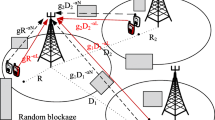Abstract
The non-line-of-sight ultraviolet (UV) communication can be applied in certain circumstances. In this paper, a graded area coverage optimization algorithm based on genetic algorithm (GACOA) is proposed to reduce the deployment cost of network and enhance the area coverage of network. Firstly, the simulation results show that the GACOA approach can improve the coverage ratio and save the deployment cost. Then, the performance of GACOA with different communication angles and number of nodes is simulated and analyzed. When the GACOA, PFCEA, and CSRCA are applied in the UV network, the performance metrics of GACOA are better than that of PFCEA and CSRCA in the same UV network. Therefore, the deployment of the UV network can be completed efficiently with a low deployment cost.













Similar content being viewed by others
References
Zhengyuan, X., Sadler, B.M.: Ultraviolet communication: potential and state-of-art. IEEE Commun. Mag. 46(5), 67–73 (2008)
Luettgen, M.R., Shapiro, J.H., Reilly, D.M.: Non-line-of-sight single-scatter propagation model. J Opt. Soc. Am. A 8(12), 1964–1972 (1991)
Xiao, H., Zuo, Y., Jian, W., Guo, H., Lin, J.: Non-line-of-sight ultraviolet single-scatter propagation model. Opt. Express 19(18), 17864–17875 (2011)
El-Shimy, M.A., Hranilovic, S.: Spatial-diversity imaging receivers for non-line-of-sight solar-blind UV communications. J. Lightwave Technol. 33(11), 2246–2255 (2015)
Chen, G., Abou-Galala, F., Xu, Z.: Experimental evaluation of LED-based solar blind NLOS communication links. Opt. Express 16(19), 15059–15068 (2008)
Vavoulas, A., Sandalidis, H.G., Varoutas, D.: Connectivity issues for ultraviolet UV-C networks. J. Opt. Commun. Netw. 3(3), 199–205 (2011)
Guo, L., Liu, Y., Wang, F., Hou, W., Gong, B.: Cluster-based protection for survivable fiber-wireless (FiWi) access network. IEEE/OSA J. Opt. Commun. Netw. 5(11), 1178–1194 (2013)
Taifei, Z., Yanling, F., Xizheng, K., Hua, H.: Research on the coverage area of communication in the solar-blind UV communication network. Acta Opt. Sin. 30(8), 2229–2235 (2010)
Ai, J., Abouzeid, A.A.: Coverage by directional sensors in randomly deployed wireless sensor networks. J. Comb. Optim. 11(1), 21–41 (2006)
Tezcan, N., Wang, W.: Self-orienting wireless multimedia sensor networks for occlusion-free viewpoints. Comput. Netw. 52(13), 2558–2567 (2008)
Tezcan, N., Wang, W.: Self-orienting wireless multimedia sensor networks for maximizing multimedia coverage. In: Proceedings of the Communications ICC’08. IEEE International Conference, pp. 2206–2210. Beijing (2008)
Cai, Y.L., Lou, W., Li, M.L., Li, X.Y.: Target-oriented scheduling in directional sensor networks. In: Proceedings of the Annual Joint Conference. IEEE Computer and Communications Society (INFOCOM), pp. 1550–1558, May (2007)
Khatib, O.: Real-time obstacle avoidance for manipulators and mobile robots. Int. J. Robot. Res. 5(1), 90–98 (1986)
Howard, A., Mataric M.J., Sukhatme, G.S.: Mobile sensor network deployment using potential field: a distributed scalable solution to the area coverage problem. In: Proceedings of the 6th International Symposium on Distributed Autonomous Robotics Systems (DARS02) Fukuoka, pp. 299–308, Japan, June 25–27 (2002)
Wang, X., Wang, S., Ma, J.J.: An improved co-evolutionary particle swarm optimization for wireless sensor networks with dynamic deployment. Sensors 7(3), 354–370 (2007)
Zou, Y., Chakrabarty, K.: Sensor deployment and target localization based on virtual forces. In: Proceedings of the IEEE INFOCOM, San Francisco, CA, pp. 1293–1303 (2003)
Tao, D., Ma, H., Liu, L.: A virtual potential field based coverage enhancing algorithm for directional sensor networks. J. Softw. 18(5), 1152–1163 (2007)
Zhao, J., Zeng, J.C.: A virtual centripetal force-based coverage-enhancing algorithm for wireless multimedia sensor networks. IEEE Sens. J. 10(8), 1328–1334 (2010)
Jie, H.: Research on Algorithm of Coverage of Video Sensor Network. School of Instrument Science and Engineering, Southeast University, Nanjing (2013)
Gage, D.W.: Command control form aw-robot systems. In: Proceedings of the l9th Annual AUVS Technical Symposium, Huntsville, AL, June 22–24 (1992)
Guo, L., Hou, W., Zheng, Z., Gong, X., Lv, S.: Green provisioning of many-to-many sessions over WDM optical networks. IEEE/OSA J. Lightwave Technol. 31(20), 3289–3301 (2013)
Holland, J.H.: Building blocks, cohort genetic algorithms, and hyperplane-defined functions. Evol. Comput. 8(4), 373–391 (2000)
Acknowledgments
This paper is supported by Natural Science Foundation of China -Civil Aviation Administration of China Joint Research Fund (No. U1433110), The Industrial Public Relation Project of Shaanxi Technology Committee (No. 2014K05-18), Research Project of Shaanxi’s Ministry of Education (No. 2013JC09), Natural Science Basic Research Plan in Shaanxi Province of China (Nos. 2013JQ8011, 2013JC2-15) and Science Program Project of Beilin District in Xi’an (No. GX1302).
Author information
Authors and Affiliations
Corresponding author
Rights and permissions
About this article
Cite this article
Taifei, Z., Yingying, G. & Ying, Z. An area coverage algorithm for non-line-of-sight ultraviolet communication network. Photon Netw Commun 32, 269–280 (2016). https://doi.org/10.1007/s11107-016-0622-7
Received:
Accepted:
Published:
Issue Date:
DOI: https://doi.org/10.1007/s11107-016-0622-7




